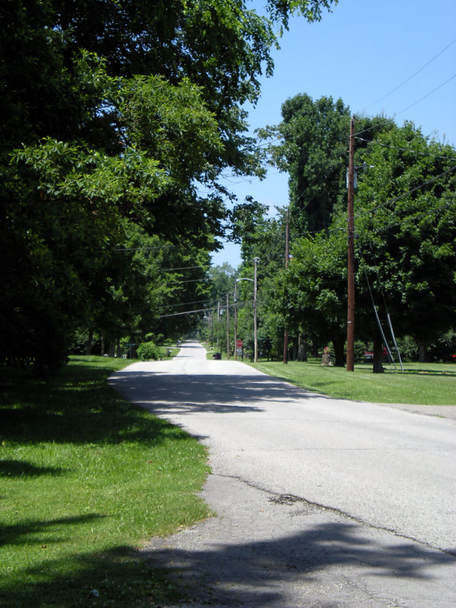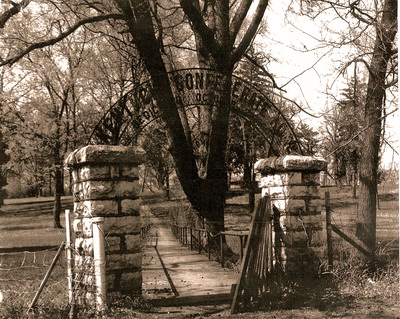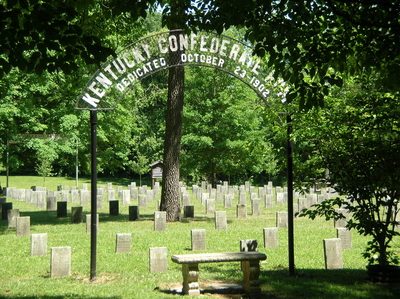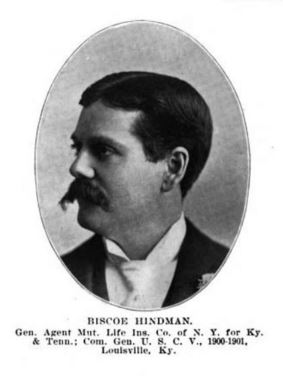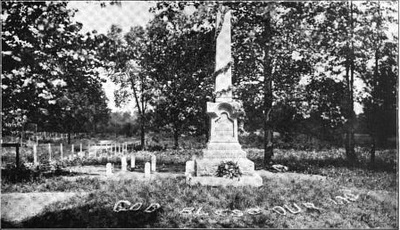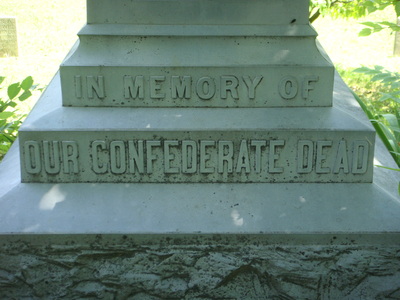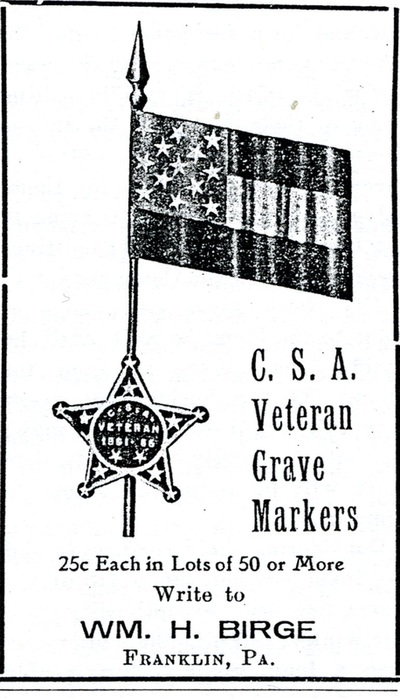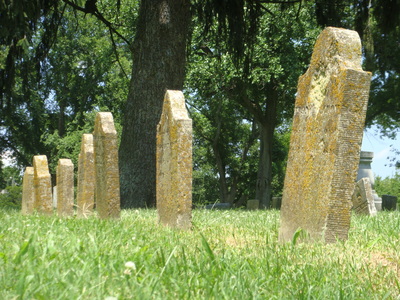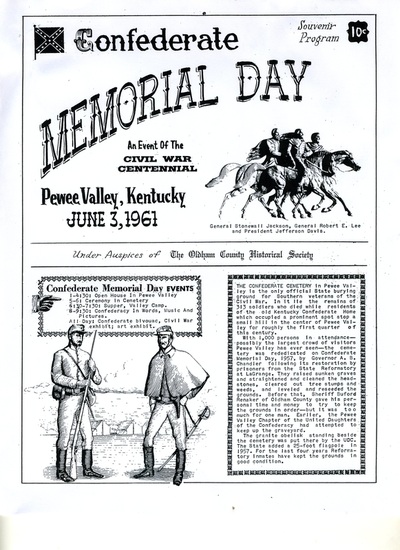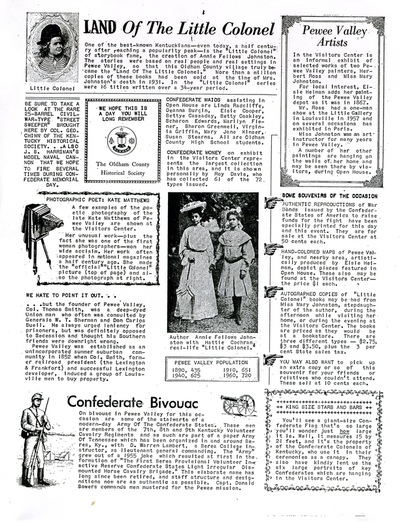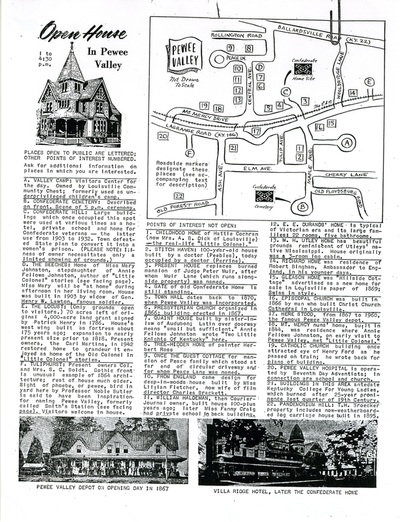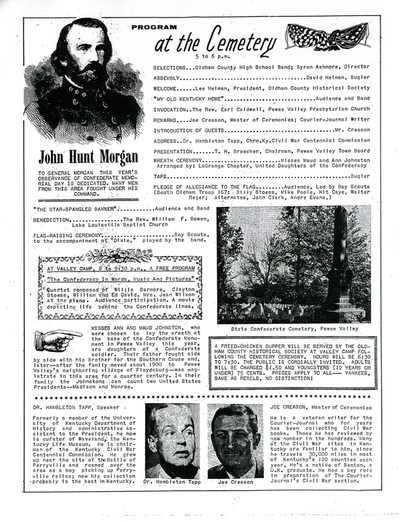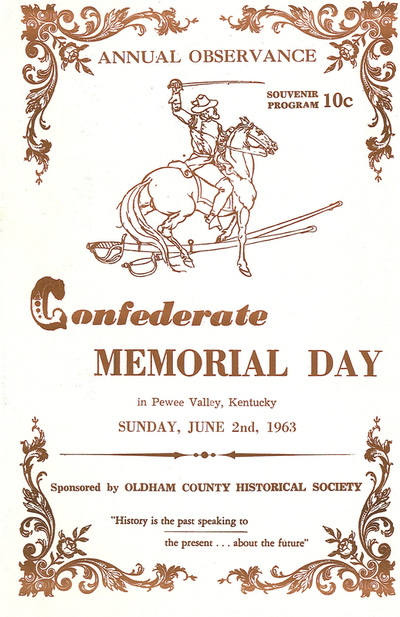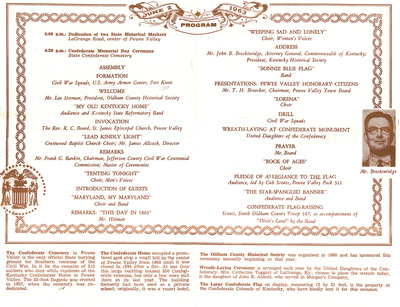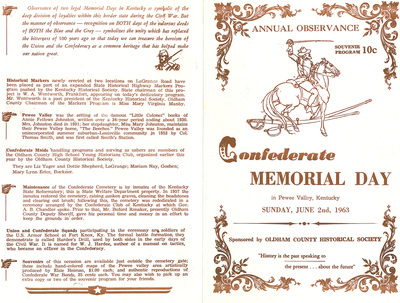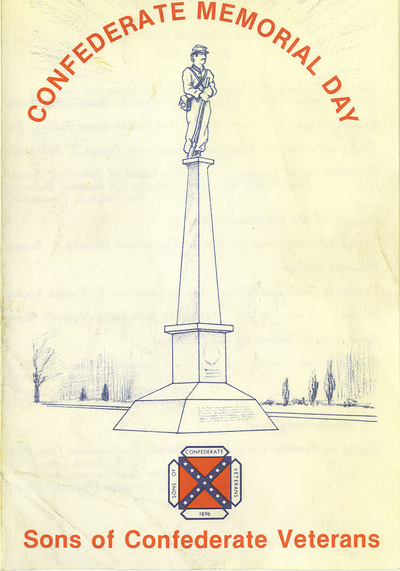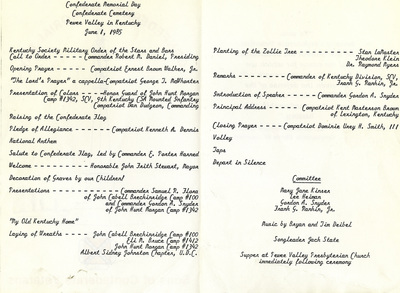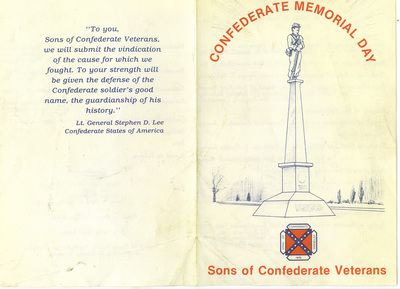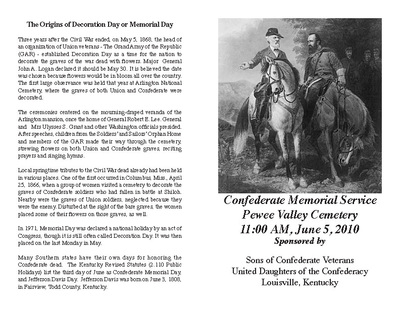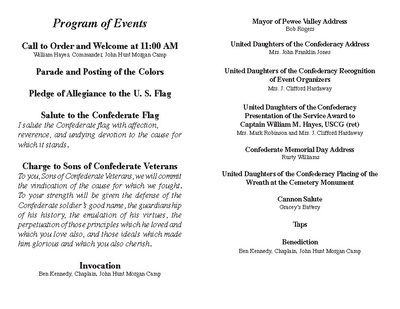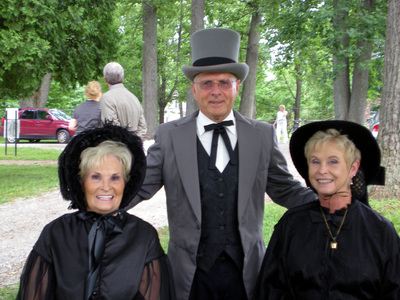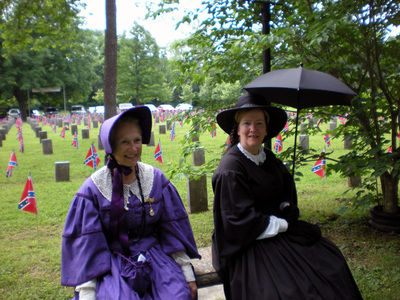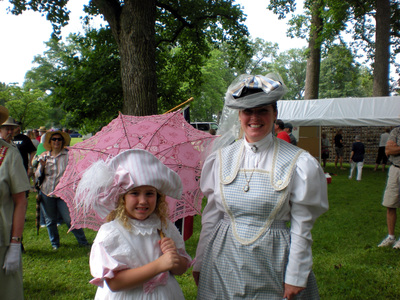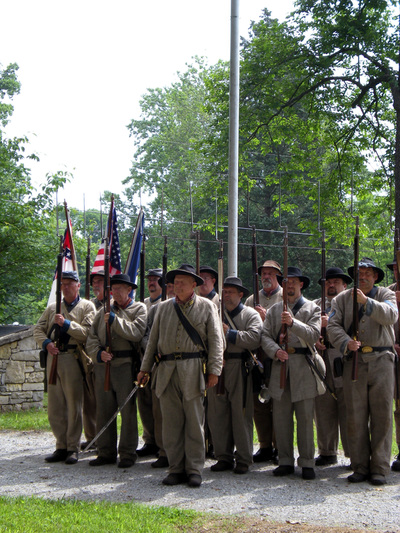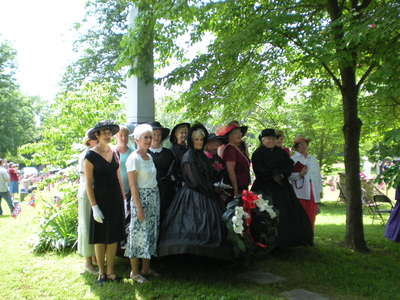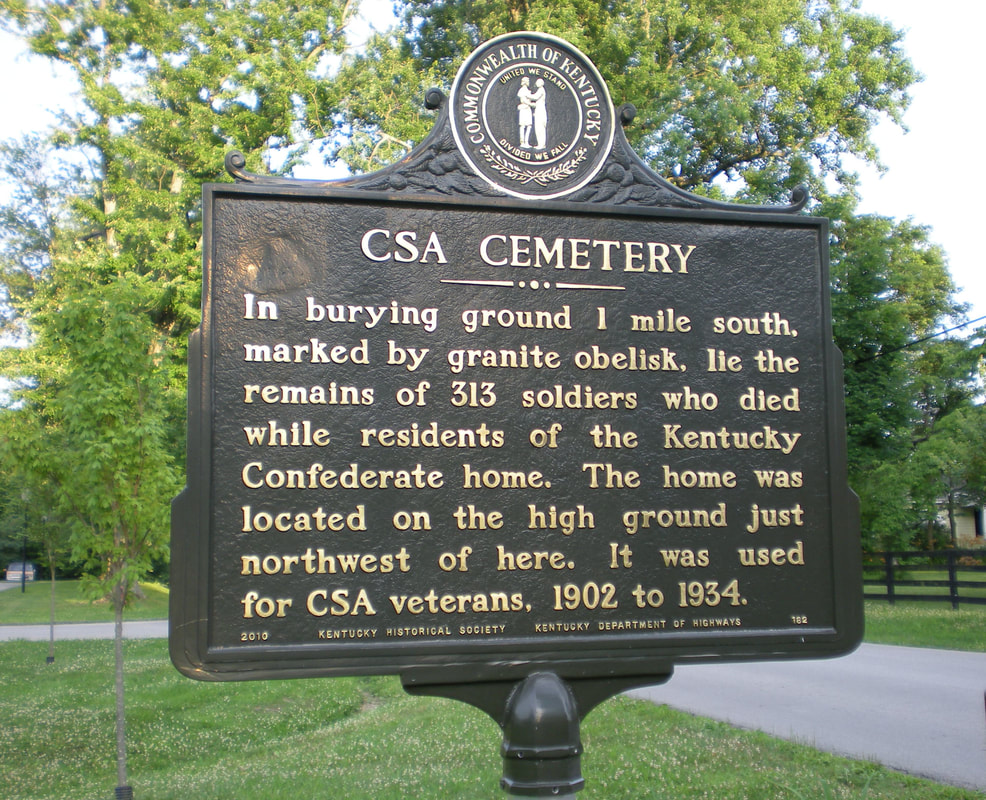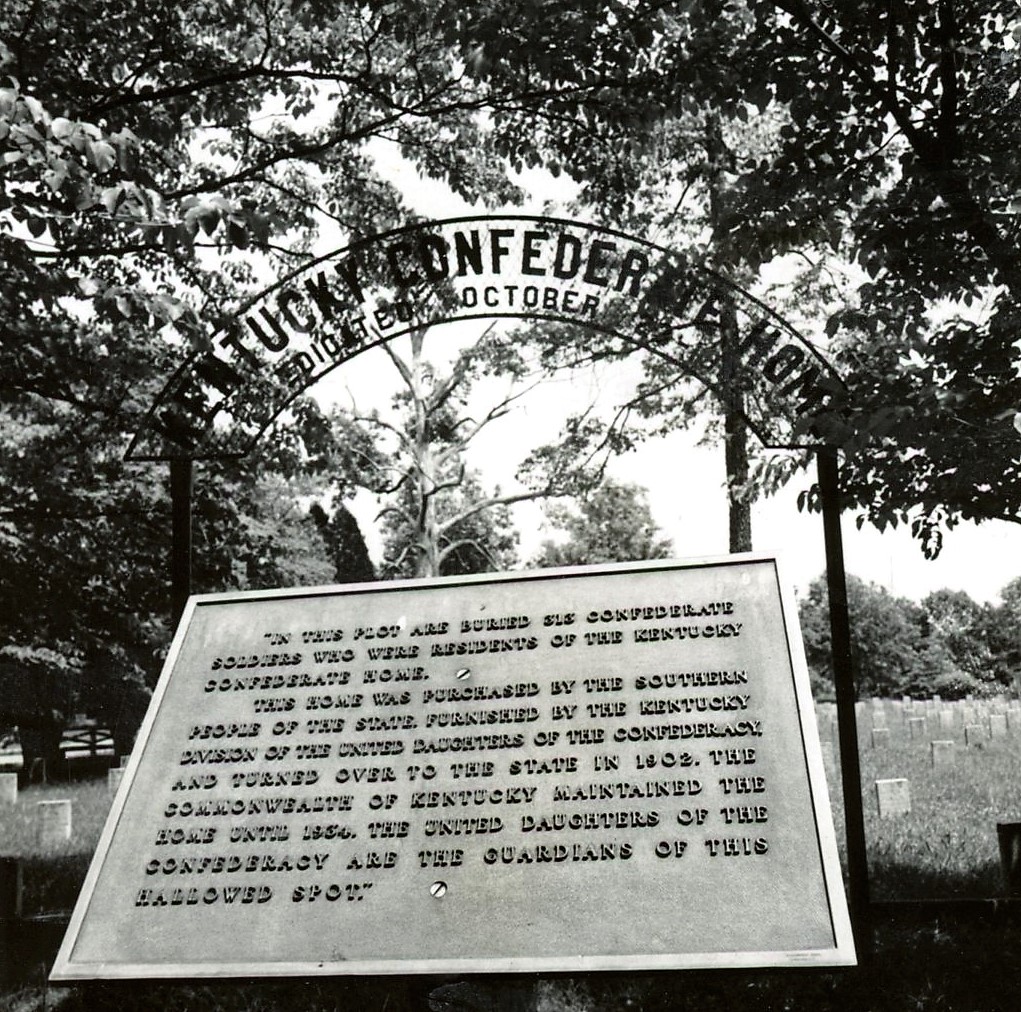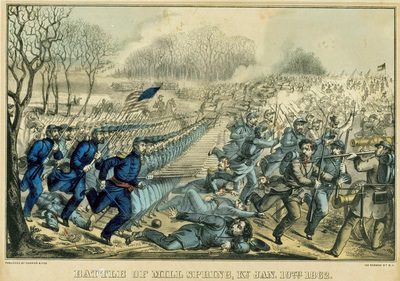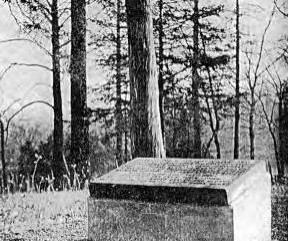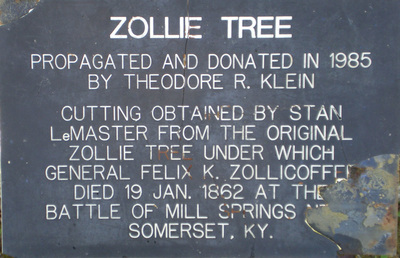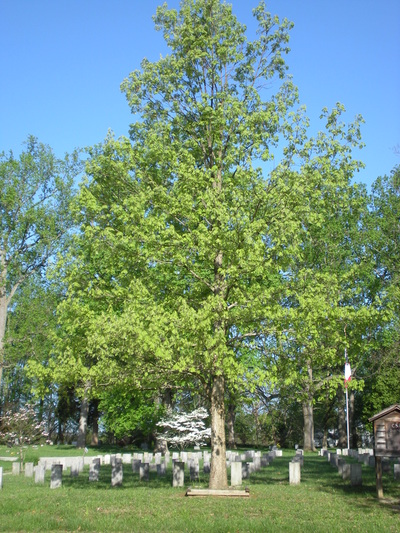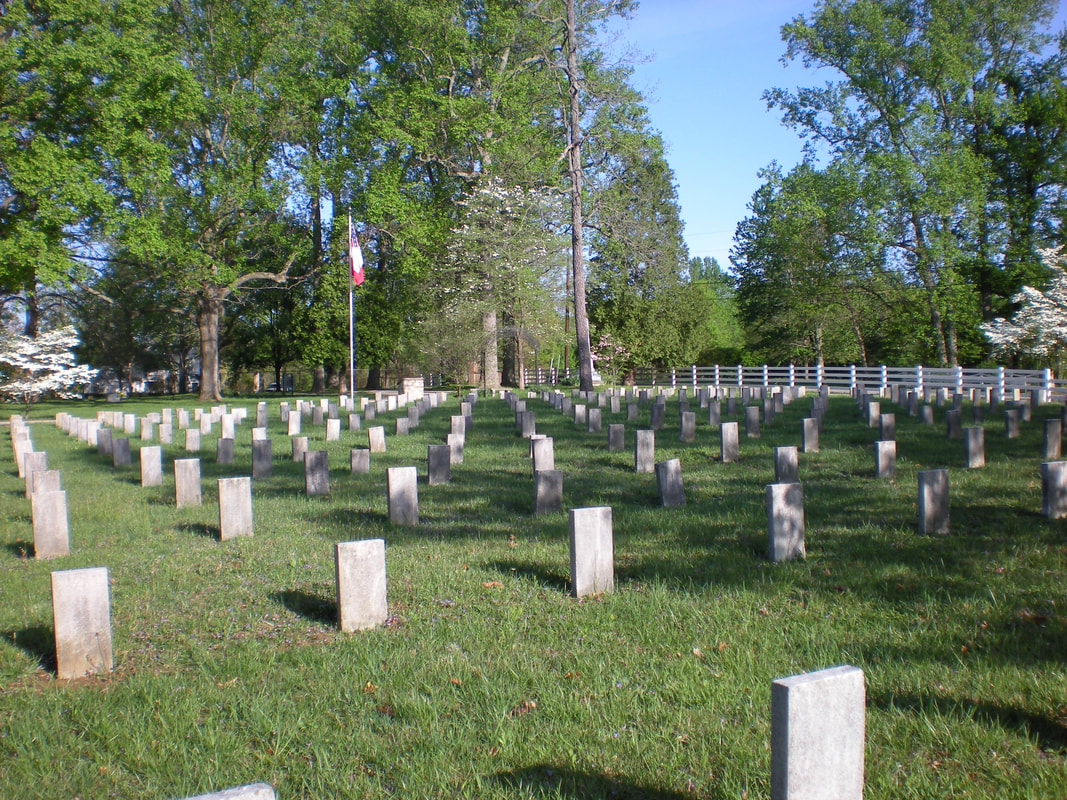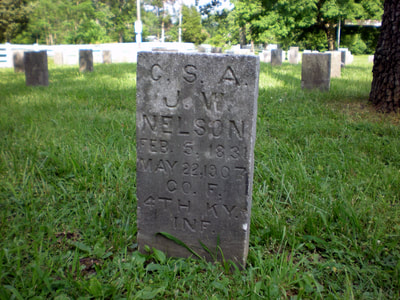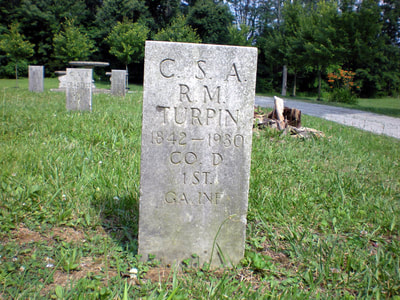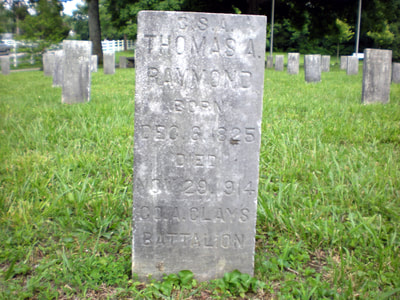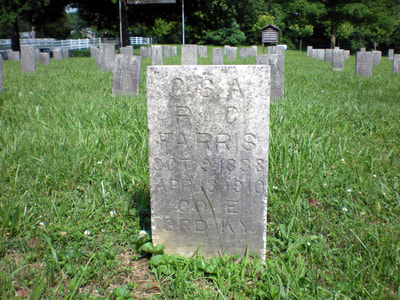Confederate Burying Ground - Pewee Valley Cemetery
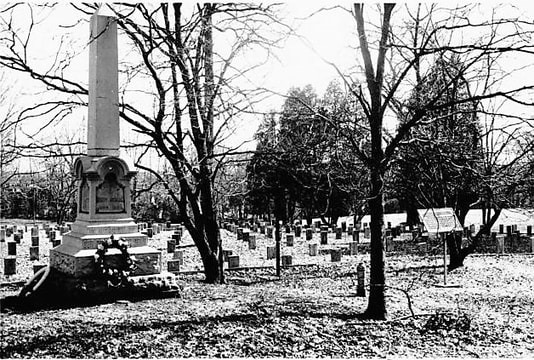 Photo from the National Register of Historic Places nomination, October 1989. Photo from the National Register of Historic Places nomination, October 1989.
. In 1904, Pewee Valley Cemetery assigned 11,275 square feet to the Commonwealth of Kentucky for use by the Kentucky Confederate Home. Marked by an obelisk inscribed with, “In memory of Our Confederate Dead,” the Confederate Burying Ground eventually became the resting place for 313 men, mostly inmates of the Home. Today, it’s one of 61 Kentucky Civil War monuments on the National Register of Historic Places and is the state’s only official burying ground for Confederate soldiers.
For more than a century, the United Daughters of the Confederacy (UDC) and Sons of Confederate Veterans (SCV) have held a memorial service at the burying ground and decorated the graves with flags on Kentucky Confederate Memorial Day, observed on the Saturday closest to Confederate States of America President Jefferson Davis’s birthday (June 3, 1801). This story from the June 11 Confederate Home Messenger describes a typical service, which was referred to as “the decoration of the graves.” The decoration of the graves of the men who died in the Confederate Home, took place Saturday, June 10, in the Pewee Valley Cemetery. Gen’l Wm. B. Haldeman, Com’d of Ky. Div. U.C.V., made a short talk. A prayer and two songs by the Veterans, with the scattering of flowers on the graves, completed the exercise. The walk of one mile (editor’s note: from the Kentucky Confederate Home off Central Avenue, across the railroad tracks and down Maple Avenue to the cemetery) is one of the prettiest in the state, like a smooth country lane densely shaded by broad spreading maples on either side, but the afternoon was very warm and few of the Veterans were able to take the walk. Flowers were scarcer than usual owing to the very dry weather and the Crimson Rambler bloom being blighted, but to the several friends who kindly remembered to send us flowers, we extend our most sincere thanks. |
|
The Obelisk
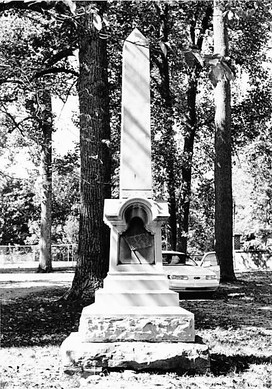 Photo from the National Register of Historic Places nomination, July 1997.
Photo from the National Register of Historic Places nomination, July 1997.
There’s a story about the obelisk in the cemetery. When Pewee Valley was notified the monument was being delivered, Albert Stoess, local carpenter and nephew of Milton Stoess of Stoess Funeral Home, rounded up all the strong men in the area to move it from the train to a waiting wagon and then to position it in the cemetery. “They expected it to be made out of marble…and to weigh a couple of tons,” says his son, Bert. However, when they got to the station, they found the monument was made out of pot metal and only weighed a couple hundred pounds. “Three men could have handled it,” Bert observes.
The obelisk is actually made of zinc -- the only zinc obelisk among the two dozen or so Civil War obelisks erected in Kentucky. It was designed by Miss Florence Barlow, a U.D.C. member who worked as the bookkeeper at the Kentucky Confederate Home for many years and wrote the institution’s monthly newsletter, the Confederate Home Messenger. The obelisk was placed in the cemetery during the annual decoration of the graves in June 1904 and is now on the National Register of Historic Places.
The man who generously opened his wallet to pay for the monument was Col. Biscoe Hindman of the Sons of Confederate Veterans. His father was Thomas Carmichael Hindman, a former U.S. Congressman, who raised a Confederate regiment at his own expense in Arkansas and was eventually promoted to major general during the Civil War. Mrs. B.A.C. Emerson tells how Col. Hindman was persuaded to underwrite the cost of the obelisk in “Historic Southern Monuments: Representative of the Heroic Dead of the Southern Confederacy” (Neale Publishing Company: 1911):
…The erection of the monument was due to a pathetic incident. Some months ago when one of the old soldiers was dying at the Home he was asked where he desired to be buried, and he replied: “Just put me over with the other boys in the cemetery here.” As grave after grave was added to the Confederate lot in the Pewee Valley Cemetery, it was thought that a monument for these brave men would be a fitting recognition of their valor and courage. General Bennett H. Young was talking to Colonel Hindman about the Home, and incidentally mentioned the above pathetic incident, when Colonel Hindman immediately remarked that he would consider it a privilege and an honor to be permitted to erect the monument, and directed General Young to go ahead and put up the monument and send him a bill. As a result Colonel Hindman presented the monument in a graceful address, in which he paid high tribute to the brave men before him and the cause they represented. He claimed the right to call them comrades by inheritance, saying” “Because he whose name I bear, and whom I honor above men, drew his sword – stainless like the sword of Robert E. Lee – in defense of his country and poured out his blood at Chickamauga and Shiloh, I thank God that I am permitted the high privilege of presenting this monument to-day to my father’s comrades for the brave soldiers of the Kentucky Confederate Home. We sing the praises of the Southern soldiers, won on many a glorious field, where there victories were ever tempered with mercy, and where they were ever magnanimous to the foe. With equal pride they sing their defeats, which only served to add still greater luster to the laurels that circle round their names. Though the Southern soldiers fought an army with superior munitions of war and with far greater numbers and resources, it is remarkable how few times the starry cross went down in defeat, and this is no detraction from the glories of the brave men who fought under the stars and stripes…..
The Tablet
The tablet at the Confederate Burying Ground shown in the photo above was dedicated by the Kentucky Division of the United Daughters of the Confederacy (U.D.C.) at 3:00 p.m. on Saturday, September 27, 1941. The September 26, 1941 Courier-Journal provided a preview of the event, which also included the presentation of crosses for military service to three men who served in World War 1 and were also descended from Confederate veterans: Reuben Thornton Taylor, James Ratecliff and Hall Ratecliff.
U.D.C. members who took part in the service included "Mesdames H.J. Stone, Virginia Wetherby, John Woodbury, Josephine Turner, Parker Taylor, Will Ed Cuigid (editor's note: This is probably a typo and should read Duigid) and Misses Joan Turner, Sarah Ramie and Mellie Hardin," according to the newspaper report.
Rededication in 1979
On August 19, 1979, the Confederate Burying Ground was rededicated. The ceremony was conducted by members of the Louisville Civil War Round Table, United Daughters of the Confederacy, Sons of the Confederate Veterans, Military Order of the Stars and Bars, Children of the Confederacy, Cumberland Valley Civil War Round Table, and the citizens of Pewee Valley. The Oldham County High School Band also performed at the event.
The Zollie Tree
There’s a very special oak tree growing near the graves of the Confederate veterans. That oak was propagated by horticulturist Theodore R. Klein, creator of Yew Dell Gardens in Crestwood, from a cutting from the original Zollie Tree at Mill Springs, Ky. near Somerset.
On January 19, 1862, the battle of Mill Springs pitted Union Brig. Gen. George Thomas against Confederate forces led by Maj. Gen. George Crittenden. One of the Confederate soldiers killed in the clash was Gen. Zollicoffer, who met his fate beneath a large oak tree.
Forty years later, a young girl noticed that though the graves of Union soldiers were decorated on Memorial Day, the mass Confederate grave site near the Zollie Tree, where Zollicoffer fell, was ignored. The Civil War Preservation Trust recounts the story of the Legend of the Zollie Tree on their website:
The large oak tree beneath which Confederate General Zollicoffer was killed at Mill Springs, Kentucky, served as an unofficial monument to the battle.
In 1902, Dorothea Burton began the tradition of placing an evergreen wreath around the trunk. A Union veteran named Henry Trimble donated one acre of land which contained both the “Zollie Tree” and a mass grave containing over 100 unknown Confederate soldiers.
In 1910, Zollicoffer Park was dedicated. Monuments were erected in honor of Zollicoffer and those in the burial trench. The tradition of decorating the tree was continued by subsequent generations and most recently was carried on by Boy Scouts in the area. On June 6, 1995, the “Zollie Tree” was felled in a thunder storm. Its age, determined by rings, was estimated to be between 250 and 300 years old. A seeding, descended from the original tree, was planted on May 17, 1996.
Klein planted the oak, located at the rear of the Confederate Burying Ground, in 1985. The tree is marked by a small plaque.
On January 19, 1862, the battle of Mill Springs pitted Union Brig. Gen. George Thomas against Confederate forces led by Maj. Gen. George Crittenden. One of the Confederate soldiers killed in the clash was Gen. Zollicoffer, who met his fate beneath a large oak tree.
Forty years later, a young girl noticed that though the graves of Union soldiers were decorated on Memorial Day, the mass Confederate grave site near the Zollie Tree, where Zollicoffer fell, was ignored. The Civil War Preservation Trust recounts the story of the Legend of the Zollie Tree on their website:
The large oak tree beneath which Confederate General Zollicoffer was killed at Mill Springs, Kentucky, served as an unofficial monument to the battle.
In 1902, Dorothea Burton began the tradition of placing an evergreen wreath around the trunk. A Union veteran named Henry Trimble donated one acre of land which contained both the “Zollie Tree” and a mass grave containing over 100 unknown Confederate soldiers.
In 1910, Zollicoffer Park was dedicated. Monuments were erected in honor of Zollicoffer and those in the burial trench. The tradition of decorating the tree was continued by subsequent generations and most recently was carried on by Boy Scouts in the area. On June 6, 1995, the “Zollie Tree” was felled in a thunder storm. Its age, determined by rings, was estimated to be between 250 and 300 years old. A seeding, descended from the original tree, was planted on May 17, 1996.
Klein planted the oak, located at the rear of the Confederate Burying Ground, in 1985. The tree is marked by a small plaque.
Grave Listing
A complete listing of the men buried in the Confederate Burying Ground is available from the Pewee Valley Cemetery Company here. Though most of the 313 men laid to rest in the cemetery were inmates of the Kentucky Confederate Home, there are a few exceptions, including Thomas Jefferson Hancock, a male nurse buried in Row 2, Space 16, who requested burial with the inmates he cared for.
Related Links
National Register Nomination for Confederate Burying Ground
National Register Nomination for the Confederate Monument
Pewee Valley Cemetery
How the Kentucky Confederate Home Wound Up in Pewee Valley
Pewee Valley's Side of the Story
A 1915 Visit to the Home
What Became of the Home
Videos of the 2010 Confederate Memorial Day Celebration
Confederate Hill Map, 2010
National Register Nomination for the Confederate Monument
Pewee Valley Cemetery
How the Kentucky Confederate Home Wound Up in Pewee Valley
Pewee Valley's Side of the Story
A 1915 Visit to the Home
What Became of the Home
Videos of the 2010 Confederate Memorial Day Celebration
Confederate Hill Map, 2010

